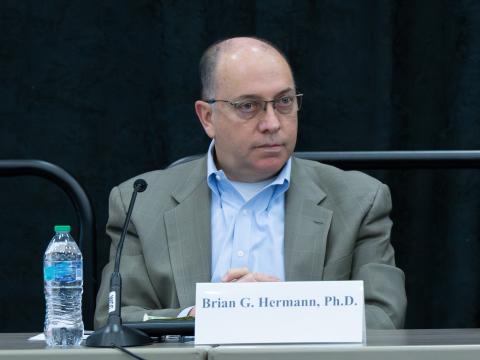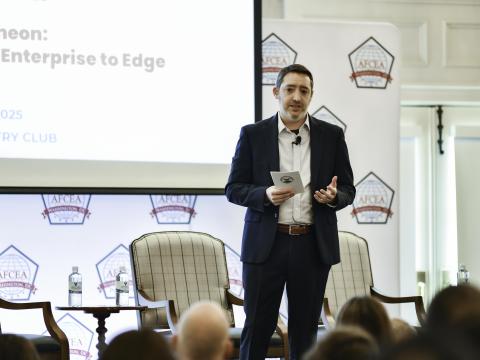Cable Company Maximizes Return on Network Investment
Extra revenues from expanded reach could total $200 million in two years.
Jim Robbins, the Harvard-educated president of one of the nation’s largest cable companies, was in southern California on a business trip when he decided to check his voice mail and got the stunning news that America Online had agreed to merge with Time Warner. The deal was not only the largest of its kind but one that promises to reshape how executives in a wide range of telecommunications businesses view the concept of convergence.
Convergence—delivering multiple sources of information and entertainment over multiple platforms, including network and cable television, telephone and the Internet—can affect more than the residential services in which Robbins’ company, Cox Communications Incorporated, is a technical leader. Its influence can also be seen on the corporate desktop as well as in the military and government markets where the company is making significant inroads in a drive for greater market penetration and increased return on network investment.
But Robbins, the 57-year-old chairman of the Atlanta-based firm, says he is not worried about increased competition from a combined American Online (AOL)-Time Warner in the 22 markets where Cox now serves more than 5 million residential customers. Instead, he is looking for opportunities to profit from the marriage.
Indeed, he says, a few days after the merger announcement, Steve Case, chairman and chief executive officer of AOL, called him and inquired about how AOL could distribute its service on Cox systems. Nothing concrete came of the call from Case, but Robbins sees it as a step in the right direction.
“For those of us at Cox, this announcement has a powerful, positive meaning,” Robbins recently told a gathering of business leaders at a Las Vegas Chamber of Commerce meeting. “It provides yet another strong endorsement that broadband networks are the best platform for providing advanced communications services.”
Nevertheless, the AOL-Time Warner merger had a note of irony for Cox Communications, a 100-year-old firm that began as an Ohio-based newspaper company. It was the second time in less than a year that the company found itself upstaged by a major telecommunications merger. On April 22, 1999, AT&T launched its surprise bid to buy MediaOne Group for $54 billion. That merger was designed to help AT&T further develop its cable franchise to offer voice service and Internet access via cable as well as through fiber optic telephone lines.
The AT&T/MediaOne announcement occurred on the same day that Robbins revealed plans to buy cable provider Media General for $1.4 billion. Robbins might have been frustrated that the company’s largest acquisition to date could not compare in news value, but he was not worried. After all, Cox Communications earned the nickname the “Quiet Leader” in the late 1980s for a reason.
That sobriquet may be more appropriate than ever as Robbins focuses on beefing up the company’s networks. Indeed, his business strategy could be likened to a four-legged stool—residential, commercial, education and government/military. For Robbins, this approach is a common-sense way to wring even more profits out of the firm’s existing networks by offering more services to current residential customers as it picks up new clients along the way.
In practical terms, that means Cox is leveraging its reputation as a high-quality, service-oriented company to sell residential customers additional products such as digital cable and Music Choice, high-speed Internet access through Cox@Home, and local and long-distance telephone services, where it competes directly with AT&T.
Adding business, education and government customers is a natural adjunct to the network, Robbins says, because the firm already has invested heavily in laying the cable in the community and can increase revenue without much additional investment.
Commercial accounts already contribute roughly $50 million in annual revenues with a corporate goal of doubling that this year and doubling it again by the end of 2001. So, Cox is clearly committed to the new markets, and Robbins says he is particularly excited about the military and government business.
“We looked around and saw there were a number of military installations located nearby our existing platforms,” Robbins offers. “We thought it would be a lost opportunity not to provide them with services where we could do so cost-effectively and still make a buck for our shareholders. It has taken on a life of its own. The military business is a very important sector for us.”
From a marketing standpoint alone, adding government and military units to the customer base could prove helpful even if it is just a break-even proposition. The company can use these high-profile customers to convince local businesses and school districts to use the Cox network for bundled services.
So far, the multitiered approach at filling in the franchise seems to be working as the firm continues to announce new business, education and government contracts.
In the government arena, Cox is perhaps best known for its work in Hampton Roads, Virginia, which includes multiple military installations as well as contracts with public agencies.
For education, company officials see great potential for using their already installed systems for distance learning among schools within the same district or even in other districts where Cox is the cable provider. The firm recently added two-way interactive distance learning services for several schools in Virginia Beach.
In the commercial sector, the company’s new focus on small- and medium-sized businesses in its existing territories is a natural by-product of the Telecommunications Act of 1996, which ushered in a new era of competition by allowing providers to sell multiple services. For the corporate desktop market, Cox has found that companies of even relatively modest size need access to high-speed data, voice and video information capabilities.
Some key Cox contracts include:
• Langley Air Force Base, Virginia: Cox provides the facility with 20 private-line circuits used for alarm systems at satellite locations. For voice services, the company supplies 600 Centrex lines that comprise voice mail as well as integrated services digital network (ISDN) items that include 14 switched primary rate interface (PRI) T-1 connections. Cox also supplies numerous private-line circuits to 11 other military/government facilities in the area.
• Tinker Air Force Base, Oklahoma: Cox furnishes a total communications package from voice (PRIs/T-1s) to Tinker’s switch and local-loop access as well as data connectivity and Internet access. The firm also has a contract with the Government Services Administration in Oklahoma City that includes a host of services from Centrex, PRIs/local dial-tone to the agency’s switch/PBX and some data circuits.
• City of Norfolk, Virginia: The firm provides the city with 16 megabits per second of bandwidth for local area network to wide area network connectivity, supplying 65 schools with data networking capabilities. Additionally, 17 municipal buildings are taking advantage of Cox’s T-1 and T-3 products and services.
• Virginia Beach, Virginia, school system: In addition to free cable television service, the company interconnects 83 Virginia Beach school facilities in a wide area network that enables students to participate in distance learning events through high-speed Internet access. Teachers and administrators also transfer student files and share curricula across the network. As the sole provider of the network, Cox provides 10-megabit-per-second connections for the school sites.
• San Diego State University, California: Cox provides all voice and video services by supplying cable television and dial-tone/trunking to the university’s telephone switch.
• The University of New Orleans, Louisiana: The school obtains its PRI ISDN trunk through Cox and uses the system to build a dial-up pool for the university’s 17,000 students, faculty and staff. Using the broadband connection, the university community can dial into the campus network from any location with Internet access.
• Gigatron Software Corporation, Orange County, California: The firm is partnering with Gigatron to create an innovative solution for the local health care industry. Using a software-imaging program called FILEflo, Cox and Gigatron can provide health maintenance organizations, their satellite locations and doctors’ offices real-time access to patients’ medical information at speeds of up to 10 megabits per second.
• Ernest M. Morial Convention Center, New Orleans: The facility hosts some of the nation’s largest technology trade shows. To attract large events in which floor exhibitors rely on high-speed network connections, Cox built the center’s data and video services network. The company furnishes wholesale 10-megabit-per-second connection speeds via a DS3 circuit connection while the Convention Center sells individual connections to the exhibitors and show sponsors.
David Woodrow, Cox’s executive vice president for new business development, says there might be an additional benefit to adding schools and business to the local cable system—centralized e-commerce. For example, having local businesses, doctors, dentists and lawyers on the same network allows them to communicate directly with consumers or each other at blazing speeds that, by definition, will not falter when Internet traffic gets too busy, he says.
“Ninety percent of all commercial transactions for consumers occur within a 10-mile radius of their homes,” Woodrow explains. “When you see the potential for wiring the world within a 10-mile radius, you ask yourself, how can we use our networks to simplify your life?”




Comments